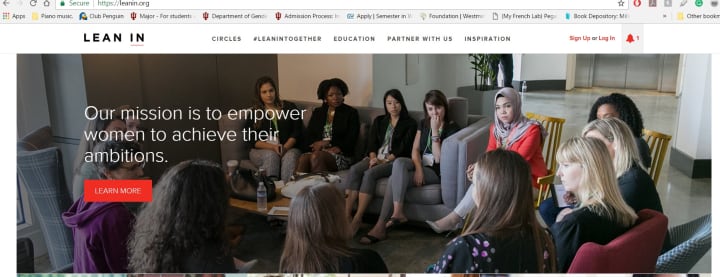
Sheryl Sandberg is the Chief Operating Officer of Facebook and in 2013 she published Lean In: Women, Work, and the Will to Lead. Her book was met with both profound praise and critique—from women. She is, after all, a woman in leadership with significant power. As such, it seems that women should be excited to hear about her tips for success so that we can be just like her. However, her book is more of a self-help book than the feminist manifesto Sandberg herself touted it to be (Sandberg 2013; Taylor 2017). More importantly, it should not be considered the cornerstone of the new feminist wave. This essay will argue that Lean In is a net loss for feminism. I will first discuss the positive impact that Sandberg and Lean In deserve credit for. After, however, I will argue for the negative impact of her book with a discussion of Risman’s (1998) idea of the three levels of gender and the capitalistic incentives behind the marketing of Lean In. I will finish with some ideas on how Lean In could have been better, and how the new LeanIn.org community can perhaps correct some of the book’s mistakes.
Maureen Corrigan (2013) of NPR writes that yes, Lean In is a bit bland and Sandberg is perhaps “somewhat blinkered by her big bucks and privilege,” but nonetheless it is “great to have a woman with such a platform speak up about sexism.” Corrigan (2013) argues that Sandberg’s merit is in organizing where she is currently positioned in society. She allows Sandberg’s elitism because she is at least having the conversation. Indeed, within the audience that Lean In is meant for—white, upper-class, heterosexual women—Sandberg’s advice rings true. Her push for women to keep their hands raised and sit at the center table does (at least minorly) improve their work environment. Perhaps one woman will get the promotion after being inspired by Sandberg to lean in. That, to Corrigan (2013), is enough.
Another benefit of Lean In is the reality of the productive advice for managing sexism at the individual and interactional level (Risman 1998). As Risman (1998) explains, sexism and gender inequality seem to exist on three main levels: the individual, the interactional, and the institutional. Risman (1998) describes the individual level as a development of gendered selves, but I prefer Sandberg’s notion of “a battle from within,” (2013: 28). The interactional level refers to the sexism within relationships, whether at home, at work, or in partnerships. Finally, the institutional level of sexism involves policy and laws—for instance, a lack of paid maternity leave and pay inequality. Instead of pushing up against the institutional barriers for women, Sandberg urges her readers to simply work harder, shake off the misogyny, and continue to lean in—thus improving their lives at the individual and interactional level. A woman’s interactions in the conference room indeed might be improved if she does keep her hand raised and assert herself into the conversation. For example, her ability to stand her ground could be used as leverage for a promotion. However, the one assertion does nothing to change hiring biases at the institutional level.
It would be unfair to continually critique Sandberg without commenting on the merit of her interactional advice. Monica Potts (2015), a journalist who writes about poverty for The Daily Beast, suggests that Sandberg’s greatest contribution to feminism is her interactional advice. Sandberg gives women “permission to talk about their work, take pride in it, and to admit they wanted to be successful,” (2015). As Sandberg discusses and as our class has mentioned, women in American society are still expected to put house and home before work. Sandberg tells women that they do not have to follow that expectation. In her chapter “Make Your Partner A Real Partner,” Sandberg discusses the many ways in which husbands can defy expectations and pick up some of the housework in order to give the women more time for work. Sandberg also references a recent study that finds that men who contribute to housework have more sex with their wives, winking at the reader to use that line in the bedroom. Her suggestion is to make sure that the reader, the working woman, marries someone who values her work as much as she does. This is an example of an interactional level solution, whereas an institutional level solution would be to allow equivalent paid leave for all parents. This is also an example of heteronormativity; if Lean In took a more intersectional—that is, considering the “intersecting patterns,” of oppression—approach, it would have used more inclusive language in this chapter (Crenshaw 1990: 1243).
This is harmful because Sandberg assumes her message to be universal and it is not. She does not give a disclaimer at the beginning where she says “This book is only for white, upper-class, heterosexual women.” She does not say that because she does not have to—it seems to be assumed that anyone who would pick up her book already fits that description. But Sandberg and the mainstream media promoted Lean In as if it is universal. Sandberg touts her solutions as solutions for women, without actually considering or interacting with diverse voices. She could have incorporated feminists of color, queer feminists, etc, but she did not. Assuming a universal existence is harmful to those whose existences deviate from the norm. Not only do their experiences go unheard, which is emotionally and mentally harmful to the person, but their experiences are also made to seem abnormal and thus bad or wrong (Taylor 2017). What’s more is that these generalizations distract those outside the oppressive dynamic, telling the outsider that the oppressed person’s plight is because of their own laziness and not because of the institutional or environmental oppression they face. This means that harmful stereotypes spread instead of institutional solutions.
I think that much of the work of gender studies and feminist theory is to proclaim that normalcy is projected by the white, capitalist patriarchy, and seek to dispel the idea of a normal existence. The more people within a society are told to believe in the idea of normal, the more anyone who deviates will suffer. The white supremacy, capitalistic patriarchy seeks to benefit from that suffering—their power remains unchallenged. So for feminists and critical race theorists and gender scholars to come along and challenge those norms is to challenge the power that the patriarchy holds. To challenge norms is to say that deviation is okay, good even, and that there does not need to be one supreme or ideal type of person. The issue with Lean In is that it does not challenge norms. It does not tell institutions or companies to adjust their policies, it tells women to change their attitudes. It tells women to conform to the same characteristics the men in their workplaces already exhibit. It tells women to conform to the norm.
That being said, Lean In’s merit remains in its interaction level advice. Those are the positive impacts as I see them. They do exist, but they are not enough. I think that for something to be considered a feminist manifesto it must be considerate of many identities, that is, it must be intersectional. Feminism as a movement would do better to include diverse voices into its canon. As defined by bell hooks, feminism is the movement to end sexual oppression. Sexual oppression is steeped in racism, classism, and homophobia, and thus to intersectionally understand sexual oppression is to understand racism, classism, and homophobia as well (hooks 2000). Therefore, relying on the input of only white, middle-to-upper-class, heterosexual women is to deny a true understanding of all kinds of sexual oppression, racism, classism, and homophobia. This is why the feminist canon needs a diverse range of voices—if it truly seeks to eliminate sexual oppression, it can only understand by listening to those who have experienced oppression in all of its forms (hooks 2000). Unfortunately, voices like Sandberg’s have dominated feminism since the first wave. It is time to let other women speak.
In addition to the glaring oversight, Sandberg makes no suggestions for changing institutional sexism. I have already discussed this a bit, but I would like to push further. Sandberg herself does not claim to offer any advice for eliminating sexism. Indeed, she offers an abundance of individual-level strategies for combatting sexism. The harm in only offering individual level strategies, as far as I see it, is that Lean In individualizes institutional problems (Williams 2013). Instead of advocating for pay equity, Sandberg (2013: 47) urges women to speak up for themselves when they want a raise, noting the end goal of the wage negotiation is to “achieve our objectives and continue to have people like us.” Her advice is literally to start the negotiation conversation by mentioning that “they know that women often get paid less than men so they are going to negotiate rather than accept the original offer,” (Sandberg 2013: 47). She continues by suggesting using “we” pronouns instead of “I”—“A woman’s request will be better received if she asserts, ‘We had a great year,’ as opposed to ‘I had a great year,’” (Sandberg 2013: 47). I had to laugh out loud reading this part. There are indeed merits to position oneself “as connected to a group and not just out for themselves,” but this only reinforces the notion that women are selfish bitches out to benefit themselves (Sandberg 2013: 47). A woman going into a salary negotiation with a male superior should not have to automatically defend herself against bitch stereotypes. The stereotype should not exist in the first place. So by telling women to switch their pronouns in a negotiation—an interactional level situation—to position themselves differently, Sandberg is both reinforcing and strengthening a harmful stereotype—an institutional level problem. Suggesting this kind of individual level solution distracts from the institutional level solutions.
Feminist bell hooks (2013) comes to the conclusion that Lean In does nothing to challenge the white, capitalist patriarchy quickly. hooks (2000) defines feminism as a movement to end sexist oppression, and according to that definition, Lean In is not feminist. hooks’ (2000) definition of feminism requires an intersectional approach to oppression (Crenshaw 1990). Lean In does nothing to combat racism, classism, and homophobia, which are all forms of oppression that also permeate the workplace. For example, hooks points out that Sandberg’s negotiated pay depends on the low wages of other women working at the same company. Losse, who worked at Facebook under Sandberg, points to an experience of her own where she tried to negotiate her pay, but was told that an increase in her salary would be offensive to the engineers. Even though the engineers made much more than her, the notion of an increase was offensive, as if her “rapid career rise posed a threat to them, which it didn’t,” (Losse 2013). Especially at Facebook, where there was “plenty of money and career growth to go around,” Losse (2013) finds it egregious that women’s salaries are being limited based on the men’s salaries, and can only imagine the effects of salary containment in companies that are not as flushed with cash as Facebook is. So it is clear that there are obvious individual level benefits to a woman’s increased wage and leadership, but it is important to remember that even those benefits are steeped in capitalist oppression, and do not come without their own consequences.
hooks’ (2013) broader critique of Sandberg and her Lean In feminism is that it “begins and ends with… gender equality in the existing social system.” This means that the white, capitalist patriarchy is not challenged by women following Sandberg’s advice. “Anyone who advocates for feminist politics,” according to hooks (2013), must understand that the existing social structure was formed to keep certain people oppressed and others privileged. Therefore, gender equality as hooks defines it cannot be achieved under the current, American social structure. Lean In simply does not meet that goal.
So why is it problematic for Lean In to be mass-marketed by the mainstream media? Because the mainstream media is a limb of the existing social structure. Of course the capitalist media is going to promote a book by a capitalist queen with the message of internalizing neoliberalism (Taylor 2017). Lean In and its feminism promote a capitalist message that seeks to benefit the cooperation instead of the individual. Losse writes that women are not the ones benefiting from leaning in. Instead, the capitalist, the cooperation, benefits. For example, Losse writes that Lean In does not discuss activities associated with “pleasure and nonproductive pastimes,” instead transforming the individual’s entire life into work. Sandberg thus seems to assume that “the feminist question is simply, how can I be a more successful worker?” Losse uses Sandberg’s discussion of work-family balance to illustrate this concept. As Losse puts it:
A successful working mother on the Sandberg model awakes at 5:00 a.m. to answer emails before preparing kids for school, returns home for dinner with her kids (which, like her job, is a duty the mother has to be promptly on time for), and then gets back into her email. “Once he was down at night, I would jump back on my computer and continue my workday,” she writes, acknowledging the fact that, by Silicon Valley’s own hand, “technology has extended the weekday.”
Who benefits from Sandberg working so much? Is it her husband and/or children, who seem to gracefully work around her schedule? As Losse points out, and I agree, the person who benefits the most from Sandberg’s increased labor is her boss (and, technically, Sandberg herself, who owns stock in the cooperation she works for). As for the other women who follow Sandberg’s advice, their increased workload directly benefits their employer and has a small chance of benefiting the worker. Sandberg’s optimism all but guarantees the woman who leans in a promotion, but the reality is that there is no guarantee. Because Sandberg has dedicated all of her words to focus on individual solutions, she misses the institutional biases in hiring and promotion practices. Those biases will probably still keep the worker from advancing, even though she is still leaning in as hard as she can. Without the benefit of a promotion, leaning in only requires the woman to work harder, probably with longer hours, and still only the capitalist benefits. As Losse (2013) writes, “Sandberg places a priceless value on labor itself and encourages more of it, whether paid, unpaid, or poorly paid.” This is harmful because it asks women, as well as all other workers, to do more—more emotional, physical, and mental labor—without compensating them for that work. It is unfair for workers to do more work without being compensated for it, even in a capitalistic world.
All of this adds up to mean that Lean In is a capitalistic book, written by a capitalistic author and promoted by the capitalistic media. Of course the capitalistic media wants to promote something that will serve it. Because Sandberg makes no effort to critique institutional sexism, Lean In poses no threat to the patriarchy. Lean In does not attempt to destroy the existing social structure, as hooks demands of feminist thought. Instead, Lean In reproduces and affirms institutional sexism.
Still, the Lean In book is not the end of Sandberg’s presence in the feminist sphere. In fact, the Lean In Community was entirely set up and staffed before the book was even published. They were ready to lean into their work as soon as the book hit the shelves. The Community aims to “empower women to achieve their ambitions,” (Leanin.org 2017). It promotes what it calls “Lean In Circles,” which are small groups of similarly-positioned women, who meet regularly and “learn and grow together,” (Leanin.org 2017). Leanin.org (2017) has its own campaigns that try to “change the way we think about gender,” including promoting images of women as leaders and men as caregivers and studying the state of women in cooperate America. What is interesting is that none of these campaigns to “change the way we think about gender” discuss the faults of the gender binary or institutional sexism (Leanin.org 2017). So the question becomes, what does “gender” mean to Sandberg and the Lean In Community? It seems that Lean In is trying to change the way we think about women, not gender. The attempt to use inclusive language is noted, but poorly executed. In addition, all of the pictures on the Lean In website are sure to put women of color front and center—for example, the main page describing Lean In circles features the faces of a black woman, Asian woman, and hijabi (Figure 1). Those faces are front and center, and the positionality of the photo puts the rest of the straight-haired, white women in the front, with their backs to the viewer. In this way, the photo leads one to believe that these circles are diverse, however, the vast majority of the group is white women.
It might seem shallow to analyze one photo on an entire website, but I think this particular image really does say a thousand words. The positioning and framing of the image are not accidental. The women of color are centered in the photo, instead of spread out through the group which is more realistic. It seems like the Lean In Community is overcompensating for the lack of racial diversity in Sandberg’s book. I am by no means suggesting that women of color should not be in this photo, because of course representation matters. My critique is more that I doubt that women of color are actually in these groups—mostly because I do not think women of color are too turned off by Lean In’s lack of intersectionality to participate—but the community is being marketed as if they are. Since the first edition of this paper, that same image has been moved to the front page of the website (Figure 2). This is unfair tokenism at best and completely fraudulent at worst.
In order for Lean In to be a productive contribution to the feminist canon, it needs to correct some of the issues presented in this paper. If Sandberg wants to improve the lives of all women, she must consider the perspectives of all women. If she wants to eliminate sexism in the workplace, she needs to address institutional biases. It is also crucial for Sandberg and the Lean In Community to understand the ways in which her ideas and suggestions could actually harm women who are not like her.
Figure 1

Figure 2

About the Creator
Markie M
I love books and critiquing things. Passionate about social justice and my sister.






Comments
There are no comments for this story
Be the first to respond and start the conversation.